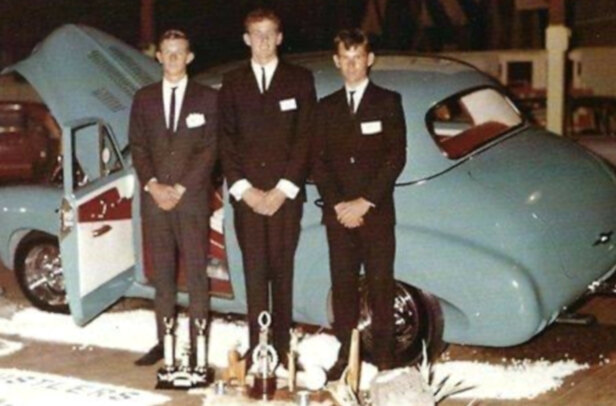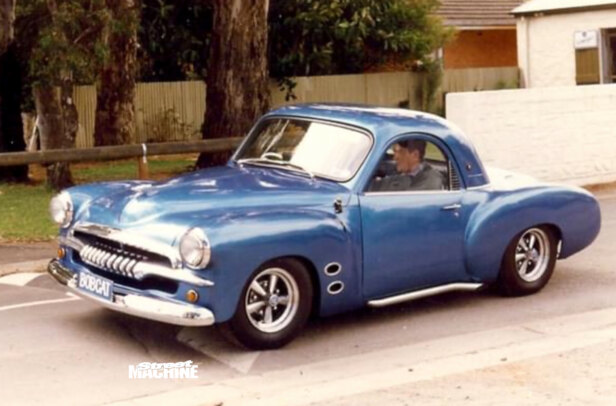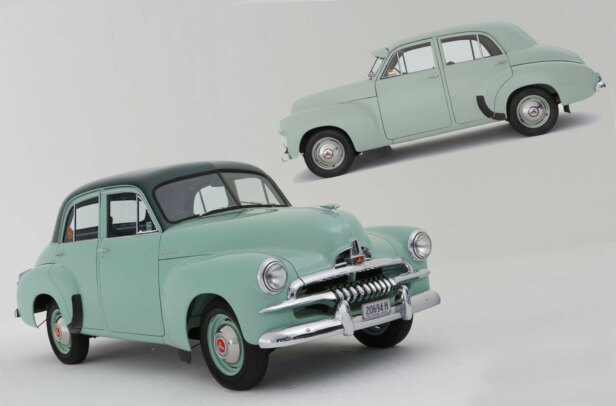The 48-215 Holden was unveiled to the public by Prime Minister Ben Chifley at Fishermans Bend on Monday 29 November 1948, and became an instant source of national pride. That first Holden – later known to most folks as the FX – was replaced in 1953 by a new version with a light facelift: the FJ. Together, those first two models, affectionally known as ‘humpies’ due to their shape, sold over 280,000 examples and kick-started Holden’s dominance of the Australian car market over the next three decades.

The FX had just 60hp to its name, but consider that when it was released, the top-selling car in Australia was the Austin A40, which was too cramped for the average Aussie family, packed a feeble four-cylinder donk and was only £31 cheaper than the Holden. The Holden was large but not heavy, and pretty fast for the price. It soon became a vital part of the Australian circuit, speedway, drag racing and custom scenes, and jump-started our local aftermarket performance parts industry.
By the 1970s, humpy Holdens were already an item of nostalgia, tapping into the first wave of rock ’n’ roll revivalism. Nevertheless, they remained an affordable car for young enthusiasts, and Aussies have been racing and modifying them ever since. Even Holden itself got in on the act in 2005 with the incredible Efijy show car.
Here we’ve compiled some of our favourite humpies ever. Crack a cold one and dive in as we celebrate 75 years of Australia’s Own Car.

1. It was in long-distance rallying that the Holden first caught the imagination of the Aussie public, most famously when Lex Davison, Stan Jones and Tony Gaze took an FX Holden to Europe for the 1953 Monte Carlo Rally, finishing 64th after covering 61,000km. The Redex, Ampol and Mobilgas round-Australia trials that followed generated massive publicity and featured Holdens aplenty.

2. The popularity of touring car racing in Australia got a massive boost thanks to FX-FJ Holdens. During the 50s, drivers including Leo Geoghegan, John French and Jack Myers ruled the roost in their highly modified humpies. Pictured here is Geoghegan’s FX, which boasted 167hp, an MG four-speed and some pioneering aerodynamic aids. The introduction of the more restrictive Appendix J rules in the 1960s kept the cars much closer to factory, but did nothing to dim the FX and FJ’s status as the budget racer’s weapon of choice, and they remained popular in club racing well into the 70s.

3. Sydney’s Dale Fisher was one of the early innovators of the early-Holden custom scene, and in 1955 he turned Roly Huyshe’s FX into a two-door convertible that looked for all the world like a factory effort. Dale built a flashier version for himself, and modified countless other early Holdens with updated grilles, tail-lights, twin-headlight conversions and more.

4. Humpys were BIG in speedway, and once again the FX and FJ remained competitive for much longer that anyone expected. For example, Alan Jones (no relation to the F1 champ) was highly successful in Queensland Unlimited Saloon racing in the early 70s in his Norman-blown, fuel-injected grey-motor FJ.

5. FXs and FJs were mainstays of the new sport of drag racing in the 1960s and well into the 70s. Ron Harrop’s ‘Harrop’s Howler’ is probably the best-remembered car today, but there were scores of others, including Warren Armour’s chop-top FJ, Brian Keegan’s ‘Keegan’s Kustom’, Dennis Syrmis’s ‘Time Machine’ and Jeff Burnett’s ‘Alki Burner’.

6. In the US, the 1949-’51 Mercury was the ultimate choice as a basis for a custom car, but here in Australia, FX-FJs played that role. Thousands were built, but among the most famous was Tony Andrew’s ‘Blue J’, which boasted quad-canted headlights, metalflake paint, sweetly flared guards and a set of Tony’s own Kustom City mags.

7. Rob Martin, Ray Miles and Peter Wileman’s FX was the progenitor of one of the sport’s greatest cars. They gutted the body and mounted it over a 1950 Prefect chassis, with a 327 Chev set back through the firewall. Dubbed ‘Shaker’, the car debuted at Calder Park’s opening drag event in April 1968 and rapidly improved to an 11.45@114mph best. It was retired in November ’69. The purple flake-painted humpy convinced GM-H execs to hand over a new HK Monaro for the team to convert into the famous ‘Shaker’ Funny Car.

8. Joe Pirotta bought his FX for $50 in 1965 and soon added a 292 Customline V8. Although it was built to drive, it was inevitable that Joe would race it, and as its times improved to mid-13s, it became a handful on the street. Joe’s collaborator, Charlie Caruana, then bought a 289 Ford to replace the 292. The twin Carter carbs were swapped out for quad Webers, which themselves were later replaced with injection for a 13.00sec best. The street-and-stripper was sold in 1968 for a race-only Cortina, but Joe maintains that this FX was his favourite car.


9. More than a few channelled FJ coupes were built in the 60s, the most famous being Bob Moule’s Norman-blown ‘Bobcat’ and Lance Simmers’s ‘Draggin Coupe’. Unlike many cars from the custom era, both survive today.

10. The custom craze had all but disappeared by the mid-70s, replaced by the panel van and street machine scenes. Noel Harper’s Rat Catcher FX was the baddest FX-FJ of the early street machine era by a country mile, featuring a full chassis, Jaguar front and rear suspension, a heavily worked quad 48 IDA Weber-fed 350 Chev, and a B&M clutch TH400. It had ample show to match the go, with a flip front, flared guards and metallic blue duco.

11. The FJ was such a cultural phenomenon that it had a pinball machine, a rock singer and a popular film named after it. The FJ Holden is a gritty slice of late-70s Western Sydney youth culture, starring a yellow FJ alongside lead actor Paul Couzens.



12. The late Pat Fay’s ‘Humpy Mekka’ FJ hearse was an icon of the 70s and 80s hot-car scene. Pat purchased the hearse from a funeral director in Kyogle, NSW for $450 with 47,000 miles on the clock, before treating it to a never-ending series of mods that culminated in V8 power, Jag IRS, wild body mods and incredible Hammer horror movie-inspired murals by the master Frank Lee. Pat showed the car with elaborate displays that included a coffin, etching both man and van into the minds of impressionable youngsters across the country.

13. The late Ron Keegan’s FJ ute was a stunning example of a home-built, van-influenced, early-80s street machine. Highlights include tunnel-rammed 327 power, gorgeous Frank Lee murals, a Jag rear, and incredible chrome work throughout by Ron’s dad.

14. Mark Plummer’s radical FJ sedan featured a healthy roof chop, full-steel tilt front and pumped guards, and amassed a significant number of trophies during its 80s show run. Originally powered by a Hemi 265 six-cylinder, the Hermitage Red humpy was later rebuilt with a full chassis and blown small-block Chev engine, and featured a red velvet interior with HZ seats and a Torana XU-1 dash.

15. Neil Dieckmann’s immortal FJ van is one of the longest-active street cars in the country, with Neil driving the primered van from Brisbane to Griffith for the first Street Machine Nationals way back in 1975. From there, Neil went hard on the body mods, fitted a stove-hot, triple Weber-fed 202, and painted the beast black in time for the Norman G Booth van show in Sydney, where it picked up plenty of tinware. He later gave it a fresh look in silver, with a massive set of 14x10in US Racers out back.

16. In the 1980s, Wild Bill Smith’s ‘The World’s Fastest FJ’ Funny Car was one of the popular drawcards at tracks up and down the east coast. The car remains active today in the care of Roma’s Randall Mohr.

17. While grey motor-powered FJs were a drag-strip favourite well into the 70s, only a few stalwarts kept with them into the 80s and beyond. The most famed example would have to be Bob Hamilton’s ‘Captain Nitrous’. Originally known as ‘Mr Terrific’, the FJ was a testbed for Bob’s innovative nitrous systems, which helped propel the car into the 12s. Bob finally updated to a red motor in the noughties, but kept it disguised as a sideplate to fool the uninitiated.

18. George Kiprios – better known to the outside world as Rock ’n’ Roll George – was a Brisbane icon who cruised the streets in his uniquely customised FX Holden for six decades. George was a somewhat mysterious relic of the 1950s rock ’n’ roll scene, who kept on cruising as the city grew and changed around him. George passed away in 2009, but his battered Holden lives on.



19. Dave Hemsworth’s name first appeared in Street Machine alongside a tough, black, SBC-powered FX sedan (SM, Aug-Sep ’85). It was a neat thing, but his next car was a next-level deal, with Dave draping an FJ ute over a Chev LUV chassis and adding an all-Ford driveline for a cutting-edge pro street look.



20. While customs were dead as a mainstream trend in the 1980s, a Brisbane bloke named Dave Johnson kept the dream alive, first with a blue FJ, and then with ‘Jigsaw’ (SM, Oct-Nov ’87), a thoroughly modern interpretation of the traditional custom FJ. The car’s alterations dragged its 1940s styling into the 80s, almost as if Holden had never stopped making the FJ and kept doing updates.

21. Graham Oldfield’s FATRAT (SM, Dec ’90) was one of the toughest show-and-go humpies ever! Powered by a B&M-blown 454, the pumped-up FX won a swag of tinware at Summernats 4 in 1991 and made clouds aplenty in the burnout comp.

22. Ian Stillman’s FX ute proved that a custom early Holden could hold its own in the 80s, provided it was tough! The HQ Statesman front, chopped roof and fat stance imbued the ute with attitude in spades, with small-block Chev power to back it up.


23. Back when an HR front end was the height of modified humpy suspension technology, Ken Neilson (SM, Oct-Nov ’93) got his FX rolling lower than anyone by adapting a MacPherson strut suspension at the pointy end and a four-bar at the rear. A quad Weber-fed 350 provided the grunt and fat 295 T/As absorbed the punishment. The whole package was outrageously smooth inside, outside and underneath. Today the car is owned and driven with enthusiasm by NT resident John Curwen-Walker, who won the first Red CentreNATS Grand Champion title in the car in 2015.





24. John Coultis’s FJ ute became one of the few humpies to score a Street Machine cover (SM, Oct ’01). Super-smooth bodywork, custom-mixed gold duco, 18in Zepter rims and a beautifully detailed 305ci Chev TPI engine combined for a thoroughly modern street machine.




25. Pastel paint, righteous stance, Rod Lingard trim and blown SBC power were all cutting-edge stuff in the mid-90s and propelled Darryl McBeth’s FJ to SMOTY fame in 1995, shared with Howard Astill’s XA coupe. These days the car is owned by Sydney fella, Matt Eastburn.

26. Gary Beardsley called on Ken Neilson to help create what was probably the best retrotech humpy Holden of the 2000s (SM, Dec ’99). The FX build married a full chassis with Commodore strut suspension and the complete driveline out of a VN V8 Calais.




27. Holden designer Richard Ferlazzo dreamed up the ultimate clean-sheet FJ when he penned the Efijy show car, which debuted at the Australian International Motor Show in 2005. While Efijy is 800mm longer and 300mm wider than a factory humpy, Ferlazzo successfully incorporated enough original styling cues – the bullnose bonnet, front and rear guards, A-pillar, grille, badges, and bootlid-mounted centre tail-light – into his design to make it instantly recognisable as an FJ.

28. In 2006, Peter Brock and co-conspirator Phil Munday shipped an FX Holden to the UK to run at Goodwood. Working with legendary HDT genius Ian Tate, the trio concocted a lightweight tribute to the racers of old, powered by a stove-hot grey motor. Brock finished fourth in the St Mary’s Trophy race at Goodwood and won the ‘Spirit of Goodwood’ trophy.


29. Sydney racer Garth Bell took Dave Hemsworth’s ute and had chassis master Rod Andrews rebuild it with a full chassis to create a stunning racer that won awards for Best Presented and Best Engineered. After running into the nines with Buick Pro Stock power, Garth sold the car, then bought it back to reimagine it again with supercharged Mazda 20B power! He later sold it again, this time to racer Darren Mood, who campaigned it with a small-block Chev. Garth bought it back once more and fitted a ProCharged Toyota 2JZ six-pot, before selling it to Melbourne racer Shane Ellis.



30. When Rod Hadfield spotted Dave Keen’s 1BADFJ (SM, Nov ’13) at a show, he told the owner it was the best-looking example of the model he’d ever seen. High praise from the master! Dave’s build plan matched some traditional body mods (including a perfectly executed chop top and two-door conversion) with a Down Town Kustoms chassis, LS1 power and blinding House of Kolor Tangelo duco by Hills & Co to dazzling effect.

31. The most famous humpy on earth? It would have to be the Cranky Frank ute, as seen by millions in Mad Max: Fury Road. The car was originally built by Colin ‘Snapper’ Macey, an automotive artist par excellence who creates rolling works of art up in Inverell, NSW.



32. Mario Borg’s FJ ute (SM, Oct-Nov ’91) was one of the tougher humpies on the 80s scene, with its signature flip front, pumped guards and 327/Top Loader driveline. Mario’s son Chris gave the car a stunning makeover (pictured above) 26 years after it was parked up, with bright blue paint and airbags all ’round to get the ute sitting down hard over its 17 and 20in rims.


33. The late Rod Johnston and his son Hud conspired together to craft a string of highly creative, beautifully executed customs, all built on a tight budget from their back shed in Wongarbon, NSW. The final project they completed together was this incredible FJ coupe (SM, May ’11), powered by a stunningly detailed Toyota Hemi V8.



34. The desire to make street-driven FJ Holdens perform to levels the original designers could never have dreamed of remains strong – just look at Troy David’s PRIMED ute (SM, Sep ’19). Powered by a twin-turbo 427ci LSX powerplant, the FJ is knocking on the 7sec zone and has proven its show-and-go credentials by taking out the Red CentreNATS Grand Champion gong in 2018.

35. Even today, humpy Holdens remain popular at the drags. The quickest six-cylinder tintop FX-FJ of all time would have to be Jeff Ramsay’s insane supercharged ute. Originally campaigned by Ray Walker, Jeff’s wild supercharged combo has run as quick as 8.47sec at 159mph.

36. Kevin Baird’s Deluxe Rod Shop-built FX (SM, Sep’ 22) is almost a new genre of humpy, quite unlike any we’ve seen before. From a few metres away, the car can pass for a stocker with fat rubber – even a glance into the interior reveals nothing more exotic than a floor shifter. But the truth is, the sleepy vibes disguise a state-of-the-art driveline with LS2 power, Tremec six-speed and plenty more besides, all wrapped in typical Deluxe build quality.


37. True wild-custom humpy builds are rare these days, but Anthony Fuller’s FJ (SM, Jun ’22) nails the brief as the two-door humpy that Holden never built, albeit dumped on the deck for maximum attitude. The canny choice of a 235ci Blue Flame six for power added to the faux GM concept-car theme.

38. Rex Webster and his brother Tony turned their old race car into one of the most influential and internationally successful Australian street machines of all time.
Why? For starters, the FJ’s undercarriage featured hand-beaten surfaces that were better than many show-car exteriors. Every cast part on the car was ground down, smoothed off and painted to perfection. Dozens of billet aluminium parts were hand made, and it had a tubular front end – likely the first in Oz. And let’s not forget the innovative touch-control panel for all the car’s major functions, which gave the FJ its ‘High Tech’ name.
The car won Top Judged at Summernats 1 in 1988, before being shipped to the US, where it took out a raft of awards – including Top Custom Car at the invite-only Fresno Autorama in ’89 – and was road-tripped between events to boot.
Publisher Paul Beck eventually purchased the car (sans its original, highly detailed red motor) and gave it fresh trim, EFI throttlebodies and new wheels to debut at MotorEx 2008. Paul then rebuilt it again with a new two-tone theme. That incarnation was unveiled at MotorEx in 2011 and was later sold.


39. Adelaide’s Colin Townsend’s FJ was a street-legal sports sedan, a triumph of form following function.
This car was designed to drive and drive fast, with stunning bodywork by Mark Linn to widen the all-steel guards far enough to accommodate the car’s pumped-out track and massive rubber. Underneath was computer-designed suspension that utilised a grab-bag of production-car parts to make it all work.
Under the bonnet was a Weber-fed, 362ci Holden V8, backed by a Top Loader and pushed deep into the firewall to help achieve the ideal front/rear weight distribution.
The FJ took out Street Machine of the Year in 1994 and placed in the Top 10 at Summernats 8. These days, the car is in the care of Colin’s mate, Kevin Brown.




Comments